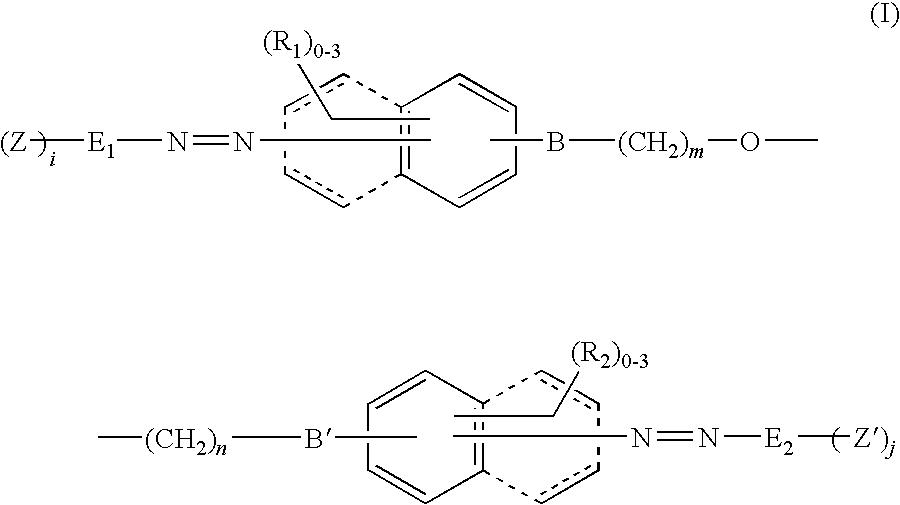Reactive dyestuff with dialkylether bridge group
a dialkylether and dyestuff technology, applied in the field of new reactive dyestuffs, can solve the problems that the levelness and wash fastness of the aforementioned novel dyestuffs cannot meet the market requirements, and achieve the effects of high fixation, improved fastness, and high color yield
- Summary
- Abstract
- Description
- Claims
- Application Information
AI Technical Summary
Benefits of technology
Problems solved by technology
Method used
Image
Examples
example 1
[0092]28.1 parts of 4-(β-sulfatoethylsulfone) aniline and 25.6 parts of 32% HCl (aq) are added into 300 parts of 0° C. water with thorough stirring to form a dispersion solution, followed by the addition of 7.2 parts of sodium nitrite. The temperature of the solution is controlled in a range of 0° C. to 5° C. until the diazotization is accomplished. Subsequently, 31.9 parts of 4-amino-5-hydroxy-2,7-naphthalenedisulfonic acid powder are added therein, and the pH value of the reaction solution is adjusted to 3 by the addition of 10 parts of NaHCO3. The reaction solution is stirred until the coupling reaction is accomplished. Next, the pH value of the reaction solution is adjusted to be larger than 12 by the addition of 45% NaOH (aq) and the temperature thereof is controlled in a range of 5° C. to 10° C. to perform reaction for 20 hours. A red aqueous solution (λmax=550 nm) is obtained, and the structure of the product is shown in the following formula (1),
[0093]
example 2
[0094]28.1 parts of 4-(β-sulfatoethylsulfone) aniline and 25.6 parts of 32% HCl (aq) are added into 300 parts of 0° C. water with thorough stirring to form a dispersion solution, followed by the addition of 7.2 parts of sodium nitrite. The temperature of the solution is controlled in a range of 0° C. to 5° C. until the diazotization is accomplished. Subsequently, 31.9 parts of 4-amino-5-hydroxy-1,7-naphthalenedisulfonic acid powder are added therein, and the pH value of the reaction solution is adjusted to 3 by the addition of 10 parts of NaHCO3. The reaction solution is stirred until the coupling reaction is accomplished. Next, the pH value of the reaction solution is adjusted to be larger than 12 by the addition of 45% NaOH (aq) and the temperature thereof is controlled in a range of 5° C. to 10° C. to perform reaction for 20 hours. The obtained product is shown in the following formula (2).
[0095]
example 3
[0096]36.1 parts of 1-aminobenzene-4-(3-sulfatoethylsulfone)-2-sulfonic acid and 30 parts of 32% HCl (aq) are added into 150 parts of 0° C. water with thorough stirring to form a dispersion solution, followed by the addition of 7.2 parts of sodium nitrite. The temperature of the solution is controlled in a range of 0° C. to 5° C. until the diazotization is accomplished. Subsequently, 23.9 parts of 2-Amino-5-hydroxy naphthalene-7-sulfonic acid powder are added therein, and the pH value of the reaction solution is adjusted to 5 by the addition of 12 parts of NaHCO3. The reaction solution is stirred until the coupling reaction is accomplished. Next, the pH value of the reaction solution is adjusted to be larger than 12 by the addition of 45% NaOH (aq) and the temperature thereof is controlled in a range of 5° C. to 10° C. to perform reaction for 20 hours. The obtained product is shown in the following formula (3).
[0097]
PUM
| Property | Measurement | Unit |
|---|---|---|
| temperature | aaaaa | aaaaa |
| temperature | aaaaa | aaaaa |
| temperature | aaaaa | aaaaa |
Abstract
Description
Claims
Application Information
 Login to View More
Login to View More - R&D
- Intellectual Property
- Life Sciences
- Materials
- Tech Scout
- Unparalleled Data Quality
- Higher Quality Content
- 60% Fewer Hallucinations
Browse by: Latest US Patents, China's latest patents, Technical Efficacy Thesaurus, Application Domain, Technology Topic, Popular Technical Reports.
© 2025 PatSnap. All rights reserved.Legal|Privacy policy|Modern Slavery Act Transparency Statement|Sitemap|About US| Contact US: help@patsnap.com



